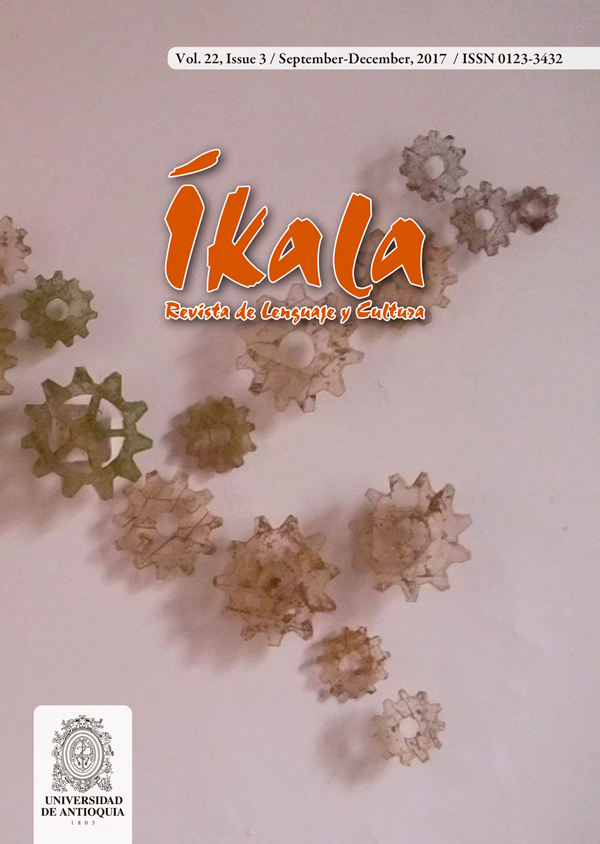Periphrastic Causativization in Toba from Eastern and Western Formosa province (Argentina)
DOI:
https://doi.org/10.17533/udea.ikala.v22n03a05Schlagworte:
syntactic causatives, grammaticalization, functional typological linguistics, verbal paradigmatic variability, GuaycuruanAbstract
The aim of this paper is to analyze, from the functionalist perspective, periphrastic causative constructions in Toba from Eastern and Western Formosa province and comparatively between the two varieties. The degree of fusion of the cause and effect predicate, their order, and paradigmatic variability are the features studied. The periphrastic causative constructions in Toba from Eastern Formosa described was not previously detected in the mutually intelligible varieties from the Chaco province. Besides, it is shown that this construction differs, especially in terms of the degree of grammaticalization, from the periphrastic construction in Toba from Western Formosa. The corpus is composed of oral texts and elicited clauses collected during fieldwork pursued in three communities: Vaca Perdida in Western Formosa, and Nam Qom neighborhood and Bartolomé de las Casas in Eastern and Middle-eastern Formosa. This paper is a contribution to comparative studies of periphrastic causative constructions of two varieties of Toba. In the absence of diachronic sources, the synchronic comparison of genetically related languages, but spoken by ethonohistorically different peoples, provides empirical evidence to hypothetically postulate grammaticalization processes in course.
Downloads
Literaturhinweise
Referencias:
Buckwalter, A. ([1980] 2001). Vocabulario toba —Seguido
de algunos Apuntes sobre la gramática del idioma toba. Roque Sáenz Peña, Chaco (Argentina): edición del autor.
Carpio, M. B. (2012). Fonología y morfosintaxis de la lengua hablada por grupos tobas en el oeste de Formosa (Argentina). Múnich: Lincom Europa.
Carpio, M. B. (2015). Estrategias de causativización en toba del oeste de Formosa (Flia. guaycurú, Argentina). En Z. Estrada Fernández, A. Fernández Garay y A. Álvarez González (Eds.), Estudios de lenguas amerindias 3. Escenarios de diversidad lingüística (pp. 73-96). Hermosillo: UniSon.
Carpio, M. B. (2016). Causativización de verbos locativos en toba del oeste de Formosa (guaycurú, Argentina). Lingüística. Asociación de Lingüística y Filología de América Latina (ALFAL), 32(2), 47-62.
Carpio, M. B., y González, R. (En prensa). Evidencialidad y modalidad epistémica en dos variedades de toba habladas en Formosa (Argentina). Lexis, xli. Lima: Pontificia Universidad Católica del Perú.
Carrió, C. (2012). Causación en mocoví. Ponencia presentada en el III Simpósio de linguística ameríndia da Associação de Linguística e Filología da América Latina (ALFAL), Universidad Federal de Río de Janeiro y el Museo Nacional, Río de Janeiro (Brasil).
Censabella, M. (2008). Derivación causativa en lengua toba. En Z. Estrada Fernández, S. Wichman, C. Chamoreau y A. Álvarez González (Eds.), Studies in Voice and Transitivity (pp. 105-125). Múnich: Lincom Europa.
Company Company, C. (2009). Parámetros de gramaticalización en los indefinidos compuestos en el español. En F. Sánchez Miret (Ed.), Romanística sin complejos. Homenaje a Carmen Pensado (pp. 71-104). Berna: Peter Lang.
Comrie, B. (1978). Ergativity. En W. P. Lehmann (Ed.), Syntactic Typology (pp. 329-394). Sussex: Harvester Press.
Comrie, B. (1989). Language Universals and Linguistic Typology. Syntax and Morphology. Chicago: University of Chicago Press. Cristófaro, S. (2003). Subordination. Oxford: Oxford University Press.
Dixon, R. M .W. (2000). A typology of causatives: Form, syntax and meaning. En R.M.W. Dixon y A. Aikhenvald (Eds.), Changing Valency. Case Studies in transitivity (pp. 30-83). Reino Unido: Cambridge University Press.
Givón, T. (2001). Syntax. A Functional-Typological Introduction (vol. II). Ámsterdam/Filadelfia: John Benjamins.
González, R. E. (2015). Estudio fonológico y morfosintáctico de la lengua toba hablada en el este de la provincia de Formosa (Argentina). Múnich: Lincom.
Gualdieri, B. (1998). Mocovi (Guaicuru). Fonologia e morfossintaxe (Tesis de doctorado no publicada). Universidade Estadual Campinas, Campinas, Brasil.
Heine, B., y T. Kuteva. (2002). World Lexicon of Grammaticalization. Cambridge: Cambridge University Press.
Instituto Nacional de Estadística y Censos (INDEC) (2012). Censo nacional de población, hogares y viviendas. Censo del Bicentenario. Resultados definitivos, Serie B N.º 2. Buenos Aires, octubre.
Klein, H. E. M. (1981). Una gramática de la lengua toba: morfología verbal y nominal. Montevideo: Dirección General de Extensión Universitaria. Ms.
Lehmann, C. (1985). Grammaticalization: Synchronic variation and diachronic change. Lingua e Stile, (20), 303-318.
Maldonado, R., y Nava, F. (2002). Tarascan causatives and event complexity. En M. Shibatani y P. Pardeshi (Eds.), The Grammar of Causation and Interpersonal Manipulation (pp. 157-196). Ámsterdam/ Filadelfía: John Benjamins.
Mendoza, M., y Wright, P. (1989). Sociocultural and economic elements of the adaptation systems of the Argentine Toba: The Nacilamolek and Taksek cases of Formosa Province. En S. Shennan (Ed.), Archaeological Approaches to Cultural Identity (pp. 242-257). Londres: Unwin Hyman.
Najlis, E. L. (1966). Lengua abipona (Archivo de Lenguas Precolombinas, N.º 1). 2 vols. Buenos Aires: Universidad de Buenos Aires, Facultad de Filosofía y Letras, Centro de Estudios Lingüísticos.
Porta, A., y Messineo, M. C. (2010). Capítulo 132: Descripción de la morfología verbal del toba utilizando lenguajes lineales libres de contexto. En V. Castel y L. Cubo de Severino (Eds.), La renovación de la palabra en el bicentenario de la Argentina. Los colores de la mirada lingüística (pp. 1065-1071). Mendoza: Editorial FFyL, UNCuyo.
Sándalo, F. (1995). A Grammar of Kadiwéu (Tesis de doctorado no publicada). University of Pittsburgh, Pittsburgh, Estados Unidos.
Shibatani, M. (2002). Introduction: Some basic issues in the grammar of causation. En: M. Shibatani (Ed.), The Grammar of Causation and Interpersonal Manipulation (pp. 1-22). Ámsterdam/ Filadelfia: John Benjamins Publishing Company.
Shibatani, M., y Pardeshi, P. (2002). The causative continuum. En M. Shibatani (Ed.), The Grammar of Causation and Interpersonal Manipulation (pp. 85- 126). Ámsterdam/Filadelfia: John Benjamins.
Song, J. J. (1996). Causatives and Causation. A Universal-Typological Perspective. Londres/Nueva York: Longman.
Song, J. J. (2013). Periphrastic causative constructions. En M. Dryer y M. Haspelmath (Eds.), The World Atlas of Language Structures Online. Leipzig: Max Planck Institute for Evolutionary Anthropology. Recuperado de http://wals.info/chapter/110.
Tovar, A., y Larrucea de Tovar, C. (1984). Catálogo de las lenguas de América del Sur. Madrid: Gredos.
Vidal, A. (2001). Pilagá grammar (Guaykuruan Family, Argentina) (Tesis de doctorado no publicada). University of Oregon, Oregon, Estados Unidos.
Veröffentlicht
Zitationsvorschlag
Ausgabe
Rubrik
Lizenz
Copyright (c) 2017 Íkala

Dieses Werk steht unter der Lizenz Creative Commons Namensnennung - Nicht-kommerziell - Weitergabe unter gleichen Bedingungen 4.0 International.












